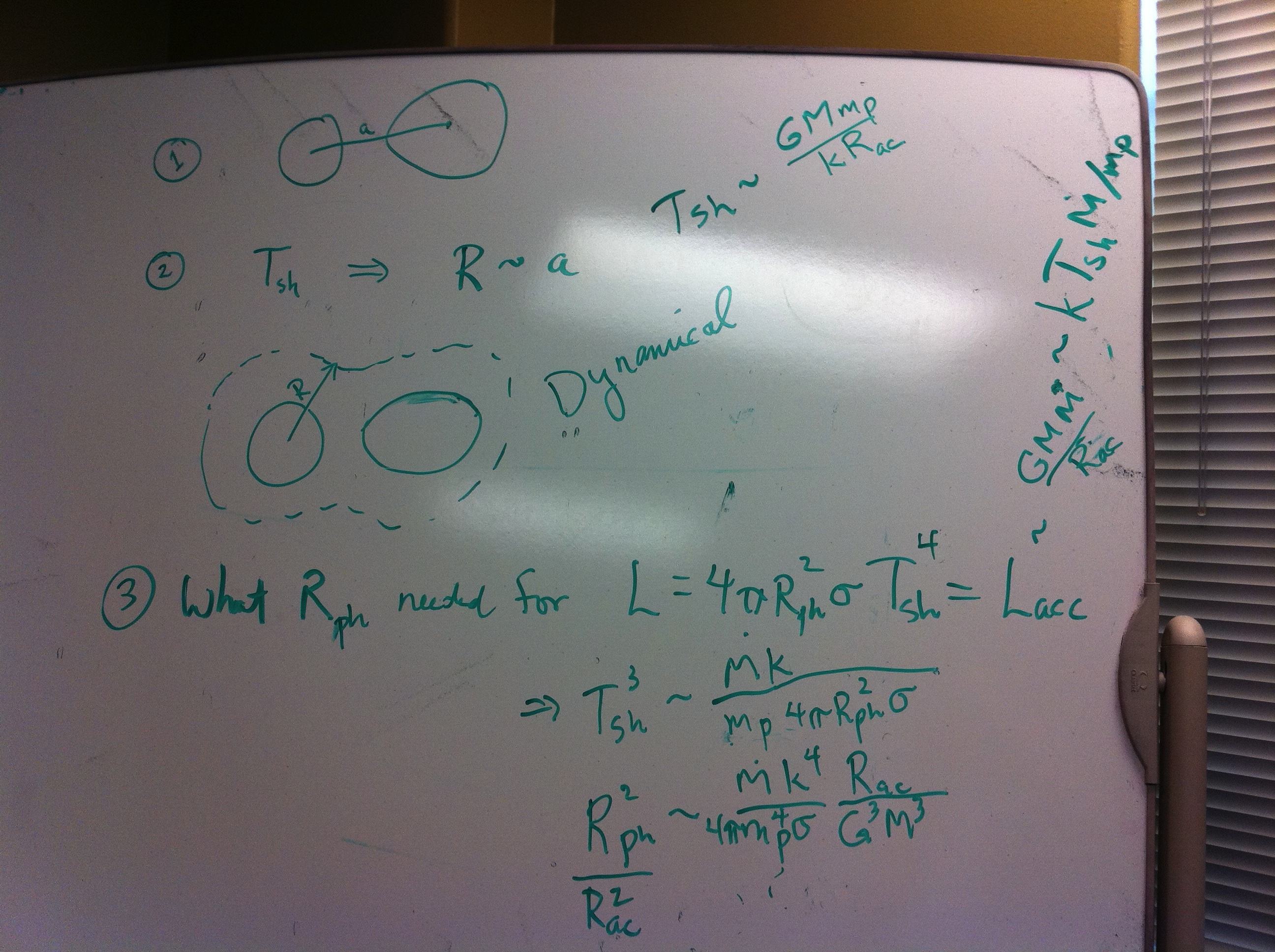Difference between revisions of "User:Tohline/Appendix/Ramblings/Photosphere"
(→More Careful Derivation: Derivation continued (3)) |
(→More Careful Derivation: Clarify a_rad) |
||
| Line 20: | Line 20: | ||
<div align="center"> | <div align="center"> | ||
<math> | <math> | ||
\Rightarrow~~~~~\biggl[ \frac{R_{ph}}{R_a} \biggr]^2 = \frac{L_{acc}}{\pi | \Rightarrow~~~~~\biggl[ \frac{R_{ph}}{R_a} \biggr]^2 = \frac{L_{acc}}{\pi a_{rad}c R_a^2 T^4_{sh}} = | ||
\frac{GM_a \dot{M}}{\pi | \frac{GM_a \dot{M}}{\pi a_{rad}c R_a^3 T^4_{sh}} \, , | ||
</math> | </math> | ||
</div> | </div> | ||
where we've set <math>4\sigma = | where we've set <math>4\sigma = a_{rad}c</math> and, | ||
<div align="center"> | <div align="center"> | ||
<math> | <math> | ||
| Line 33: | Line 33: | ||
<div align="center"> | <div align="center"> | ||
<math> | <math> | ||
\biggl[ \frac{R_{ph}}{R_a} \biggr]^2 \approx \frac{GM_a \dot{M}}{\pi | \biggl[ \frac{R_{ph}}{R_a} \biggr]^2 \approx \frac{GM_a \dot{M}}{\pi a_{rad}c R_a^3} \biggl[ \frac{kR_a}{GM_a m_p} \biggr]^4 | ||
= \frac{R_a}{\pi | = \biggl[ \frac{15(hc)^3}{8\pi^5 k^4} \biggr] \frac{R_a \dot{M}}{\pi c G^3 M_a^3} \biggl[ \frac{k}{ m_p} \biggr]^4 | ||
= \biggl[ \frac{15}{8\pi^5} \biggr] \frac{R_a \dot{M}}{\pi c m_p^4} \biggl[ \frac{hc}{ GM_a} \biggr]^3 | |||
\, . | |||
</math> | </math> | ||
</div> | </div> | ||
Revision as of 17:33, 6 May 2011

|
|---|
| | Tiled Menu | Tables of Content | Banner Video | Tohline Home Page | |
Locating the Photosphere of Stably Accreting Double White Dwarf Binaries
Context
At our regularly scheduled astrophysics group meeting on Monday, 2 May 2011, Juhan Frank and I started debating the answer to the following question: What should the photospheric radius be of the common envelope that surrounds a stably accreting, double white dwarf (DWD) binary? That is, does an accreting DWD binary that is destined to be an AM CVn system look like a single bloated star? The various mathematical relations that we think are relevant to this question were sketched on the whiteboard in room 218 Johnston Hall (CCT). Here is a photo of that whiteboard discussion and derivation.
More Careful Derivation
As the accretion stream from the less massive white dwarf impacts the surface of the accretor supersonically, it will heat the accreted material to a post-shock temperature,
<math>T_{sh} \approx \frac{GM_a m_p}{kR_a}</math> ,
where <math>M_a</math> and <math>R_a</math> are the mass and radius, respectively, of the accretor. Assuming the post-shock material is optically thick to photon radiation, we should ask to what "photospheric" radius, <math>R_{ph}</math>, the envelope of the accretor will have to swell in order for the star (in steady state) to be able to radiate all of the accretion energy? It seems that it will need,
<math> 4\pi R_{ph}^2 \sigma T_{sh}^4 = L_{acc} </math>
<math> \Rightarrow~~~~~\biggl[ \frac{R_{ph}}{R_a} \biggr]^2 = \frac{L_{acc}}{\pi a_{rad}c R_a^2 T^4_{sh}} = \frac{GM_a \dot{M}}{\pi a_{rad}c R_a^3 T^4_{sh}} \, , </math>
where we've set <math>4\sigma = a_{rad}c</math> and,
<math> L_{acc} = \frac{GM_a \dot{M}}{R_a} \, . </math>
Replacing <math>T_{sh}</math> by the approximate expression shown above gives,
<math> \biggl[ \frac{R_{ph}}{R_a} \biggr]^2 \approx \frac{GM_a \dot{M}}{\pi a_{rad}c R_a^3} \biggl[ \frac{kR_a}{GM_a m_p} \biggr]^4 = \biggl[ \frac{15(hc)^3}{8\pi^5 k^4} \biggr] \frac{R_a \dot{M}}{\pi c G^3 M_a^3} \biggl[ \frac{k}{ m_p} \biggr]^4 = \biggl[ \frac{15}{8\pi^5} \biggr] \frac{R_a \dot{M}}{\pi c m_p^4} \biggl[ \frac{hc}{ GM_a} \biggr]^3 \, . </math>

|
|---|
|
© 2014 - 2021 by Joel E. Tohline |
